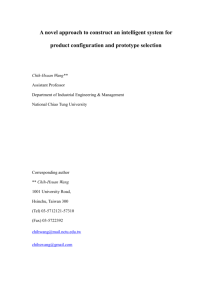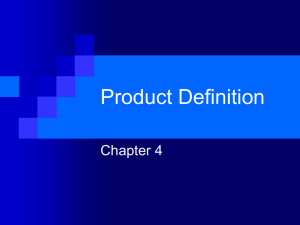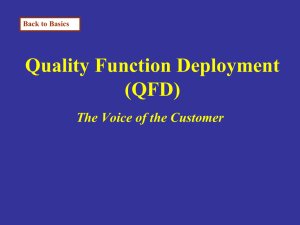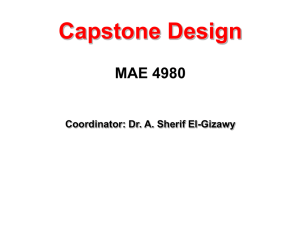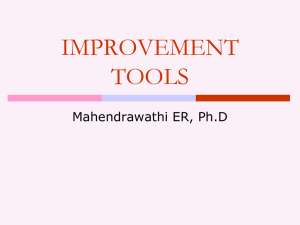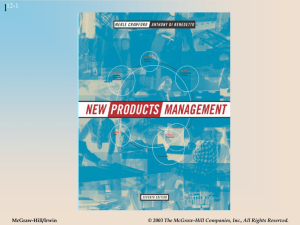Research Journal of Applied Sciences, Engineering and Technology 4(18): 3283-3288,... ISSN: 2040-7467
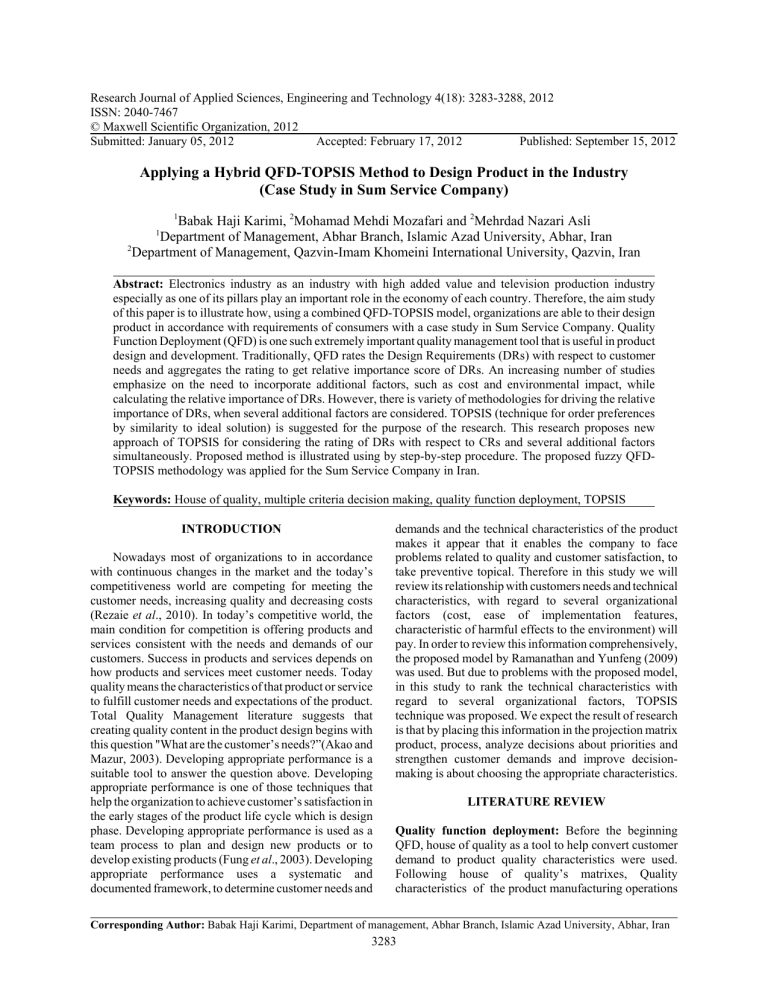
Research Journal of Applied Sciences, Engineering and Technology 4(18): 3283-3288, 2012
ISSN: 2040-7467
© Maxwell Scientific Organization, 2012
Submitted: January 05, 2012 Accepted: February 17, 2012 Published: September 15, 2012
Applying a Hybrid QFD-TOPSIS Method to Design Product in the Industry
(Case Study in Sum Service Company)
1
Babak Haji Karimi,
2
Mohamad Mehdi Mozafari and
2
Mehrdad Nazari Asli
1
Department of Management, Abhar Branch, Islamic Azad University, Abhar, Iran
2
Department of Management, Qazvin-Imam Khomeini International University, Qazvin, Iran
Abstract: Electronics industry as an industry with high added value and television production industry especially as one of its pillars play an important role in the economy of each country. Therefore, the aim study of this paper is to illustrate how, using a combined QFD-TOPSIS model, organizations are able to their design product in accordance with requirements of consumers with a case study in Sum Service Company. Quality
Function Deployment (QFD) is one such extremely important quality management tool that is useful in product design and development. Traditionally, QFD rates the Design Requirements (DRs) with respect to customer needs and aggregates the rating to get relative importance score of DRs. An increasing number of studies emphasize on the need to incorporate additional factors, such as cost and environmental impact, while calculating the relative importance of DRs. However, there is variety of methodologies for driving the relative importance of DRs, when several additional factors are considered. TOPSIS (technique for order preferences by similarity to ideal solution) is suggested for the purpose of the research. This research proposes new approach of TOPSIS for considering the rating of DRs with respect to CRs and several additional factors simultaneously. Proposed method is illustrated using by step-by-step procedure. The proposed fuzzy QFD-
TOPSIS methodology was applied for the Sum Service Company in Iran.
Keywords: House of quality, multiple criteria decision making, quality function deployment, TOPSIS
INTRODUCTION
Nowadays most of organizations to in accordance with continuous changes in the market and the today’s competitiveness world are competing for meeting the customer needs, increasing quality and decreasing costs
(Rezaie et al ., 2010). In today’s competitive world, the main condition for competition is offering products and services consistent with the needs and demands of our customers. Success in products and services depends on how products and services meet customer needs. Today quality means the characteristics of that product or service to fulfill customer needs and expectations of the product.
Total Quality Management literature suggests that creating quality content in the product design begins with this question "What are the customer’s needs?”(Akao and
Mazur, 2003). Developing appropriate performance is a suitable tool to answer the question above. Developing appropriate performance is one of those techniques that help the organization to achieve customer’s satisfaction in the early stages of the product life cycle which is design phase. Developing appropriate performance is used as a team process to plan and design new products or to develop existing products (Fung et al ., 2003). Developing appropriate performance uses a systematic and documented framework, to determine customer needs and demands and the technical characteristics of the product makes it appear that it enables the company to face problems related to quality and customer satisfaction, to take preventive topical. Therefore in this study we will review its relationship with customers needs and technical characteristics, with regard to several organizational factors (cost, ease of implementation features, characteristic of harmful effects to the environment) will pay. In order to review this information comprehensively, the proposed model by Ramanathan and Yunfeng (2009) was used. But due to problems with the proposed model, in this study to rank the technical characteristics with regard to several organizational factors, TOPSIS technique was proposed. We expect the result of research is that by placing this information in the projection matrix product, process, analyze decisions about priorities and strengthen customer demands and improve decisionmaking is about choosing the appropriate characteristics.
LITERATURE REVIEW
Quality function deployment: Before the beginning
QFD, house of quality as a tool to help convert customer demand to product quality characteristics were used.
Following house of quality’s matrixes, Quality characteristics of the product manufacturing operations
Corresponding Author: Babak Haji Karimi, Department of management, Abhar Branch, Islamic Azad University, Abhar, Iran
3283
Res. J. Appl. Sci. Eng. Technol., 4(18): 3283-3288, 2012 related to manufacturing organizations. The modern view of quality attributes that extend to all stages of product development processes from design to final production was called Quality Function Deployment (Hwang and
Teo, 2002). QFD is a well-structured, cross-functional planning technique that is used to hear the customers’ voice throughout the product planning, development, engineering and manufacturing stages of any product.
QFD, in fact, is a methodology of continuous product improvement, emphasizing multifunctional teams to integrate planning, development and engineering as well as manufacturing stages. This technique helps to measure the impact of organizational learning through innovation
(Bhattacharya et al ., 2010). In general, there are three steps associated in QFD planning ensuring that the voices of customers are heard:
C Identification of CReqs
C Identification of Ereqs
C
Determination of the importance weights for the individual CReq (Bhattacharya et al ., 2010)
Quality Function Development, method development, expansion characteristics, are features and functions that give quality to the product or service (Akao and Mazur,
2003). This process increases the quality of goods or services are based on customer needs. The definition of quality is based on customer requirements. QFD step by step develop and improve business operations and functions within the quality through the systematic components to ensure objectives (Tang et al ., 2002). QFD performance is a way to hear the customer. This means the systematic process for translating customer needs and requirements that have to be along the supply chain to reach them. Aim of expanding the quality of performance as a planning tool, reducing inconsistencies in the organization has two types: first the product features is not in accord with the needs of predetermined target customer groups the second case is that the final product is not compatible with technical features of the product
(Lai and Yang, 2008). The first tool to overcome inconsistencies between product features and voice to communicate with customers and finally the second change and move through the technical implementation of product features, details, processes and reduce production characteristics. Quality Function Development Planning
Group helps your products or services to develop higher quality and meet customer needs. Development and widespread application of QFD, its application areas in fields such as design, planning, decision making, engineering, management, working group, timing, cost and etc. Widespread and has also expanded. Development of quality performance provides particular way for quality assurance between each stage of the product development process starts with the design (Lai and Yang, 2008). To ensure service quality and new products should result not only "negative quality" in customer complaints but also expressed in the comments "positive quality" also said of the demands of our customers consider (Ozgenber, 2003).
Quality home: Quality home content that is important and useful if it is prepared accurate and appropriate, while providing valuable information product or service, it can be the end point of many development projects, quality performance (De Poel, 2007).
Determining customer needs and requirements: QFD begins with identifying customers and asking the question: "What customers want". Most of our customers’ needs through marketing research and sales are collected
(Fung et al ., 2003). You can also use other sources to determine customer needs: scrolling, the complaints of customers, standards, theories staff, all while using the product performance, product sales records this can be through the quality demands of customers, the product was determined and developed (Chan and Wu, 2002a).
Determine the importance of customer requirements and prioritize them: Since due to technical and budgetary constraints, meet all demands of customers is not possible. It is necessary to prioritize customer demands, so more important actions are used in product design. Company should ignore some demands and satisfy them are postponed to another time. In order to determine the relative importance of each customer's demands can range them from 1 to 10 (Chan and Wu,
2002b).
Assess competitors: Organization that intend to compete and effective presence in the market, should know that what is a rank and position of their product from the perspective of customers and according to their desired quality characteristics, in comparison with other competitors. To make it at home in terms of quality, rights in the matrix, the desired product with similar products competitors are evaluated (Chan and Wu, 2002a).
Communications matrix: Executive Team QFD Sets desired communication according to the views experienced professional's organization, customers and statistical data, etc., usually the sign following communication matrix is used (Hunt and Xavier, 2003):
C Strong relationship (9)
C Average relationship (3)
C Poor relationship (1)
Lack of reasonable relationship between a technical specification with quality customer demands, reflects the fact that the technical characteristics of the waste or
3284
Res. J. Appl. Sci. Eng. Technol., 4(18): 3283-3288, 2012 intended that one or more customer quality demands are not considered. lack of communication between a customer requested features Technical product, suggests that some features are not considered engineering and therefore the column matrix should be developed and completed (Fung et al ., 2003).
So the sample size required for 26 experts and community for the community is 96 clients. To increase the validity of Bartlett's test and KMO index is used.
KMO value in this study equal 0.83 and 0.00 times the amount of sig has been indicating that factor analysis is to identify the appropriate structure. also on the reliability coefficient alpha Kronbakh used in this study, alpha coefficients equal to 0.8737 is obtained, the data of the questionnaire has acceptable reliability.
TOPSIS: TOPSIS, which was first proposed by Hwang and Yoon (1981), is based on choosing the best option having the shortest distance to the positive ideal solution and the farthest distance from the negative-ideal solution
(Azadeh et al ., 2011). TOPSIS one way is a compromise subtypes. In this group the preferred option will be the closest option to the ideal solution. The following groups also compromise its subtypes compensating model.
Compensatory model exchange between indices are considered. That may be an indicator of weakness by the other index points is compensated (Chen et al ., 2006).
n
( Z
2
) *
2 pq
METHODOLOGY
This research has been implemented in the Sum
Service company. Sum Service company is a exclusive agent in Iranian Samsung products, in 2011. The company now has approximately 1000 m 2 with space and operate with 135 employees and more than 900 dealers nationwide for post sales support. It applies the most advanced laboratory equipment and computer trained and experienced engineers and personnel responsible for using the service in the country is responsible.
Research is done in terms of categories based on objective research, applied research is intended to transfer the scientific findings of fundamental research to technology field. But in terms of how to collect data and descriptive type of research is a case study of the branches. This study developed three questionnaires and questionnaire 1 has been set a number to identify customer needs and determine the importance of each is needed is with open questions. questionnaire survey of experts for the number two priority order based on the technical characteristics Four factors: customer satisfaction, cost of implementation and environmental effects are harmful. Questionnaire surveys of clients to
No. 3 in relation to effect any of the technical features of increased satisfaction in the Host. sampling in this study is simple random and the formula (1) for the experts and the formula (2 ) for customers to follow: n
2
N
2
N
1
2
Z pq
2
2
* pq
(1)
(2)
Research's model: Generally, the quality of a house is composed of six sections (matrix A to F). A section identifies customer needs and the relative importance of individual needs of customers with the survey is determined. Technical features of the matrix B and the degree of correlation between customer requirements in the matrix C is measured. In this research, customer requirements as CR and DR as technical characteristics are called. DR absolute and relative importance in the matrix E is calculated and finally the matrix F is used for the Benchmarking. Ramanathan and Yunfeng (2009) comprehensively reviewed quality homes. In the proposed method three factors of cost, ease of implementation and harmful environmental effects were studied. In the proposed model we face two fundamental problems:
C In the matrix model of communication and only
Pyshnhadyshan technical matrix used to calculate the
DR performance. While the correlation matrix modeling and quality in the home will have a significant effect in DR to determine the relative importance.
C
When we calculate the relative importance of the technical features of the DR using data envelopment analysis model, the score of performance against a
DR number will confuse organization in selecting
DR.
So to solve two problems in this study high TOPSIS technique is proposed.
Executive technique based on the model proposed:
First of all we list CR and DR. Then we modeled the appropriate numerical values for all the communication matrix, correlation matrix, the matrix of technical and allocation matrix. Then, we obtain DR using the classical expansion of quality and performance matrices A, C, E and the relative importance of each correlation matrix.
Then, regardless of the relative importance obtained using
TOPSIS techniques for any of the DR is enough to calculate the cl i
and then multiply calculate the final grade for each of the DR is enough cl i
obtained in importance
Corresponding relative. Finally, after calculating the final score for each of the DR can be ranked according to descending on.
3285
Res. J. Appl. Sci. Eng. Technol., 4(18): 3283-3288, 2012
Table 1: Wilcoxon's test
Z
Asymp. sig. (2-tailed)
Table 2: Customer satisfaction
Alternative
Image transparency
Sound clarity
Speaker efficiency
Signal strength
TV weight
Total detector color
Robustness TV cabinet
Total tuner
Quality and quantity of outputs
Memory
Sound intensity
Number of image per second
RESULTS AND DISCUSSION
Test statics
-0.135
0.893
This section will first review the method that combines quality performance TOPSIS technique development and integration of design requirements in line with organizational and environmental factors in the goods or services, can be suitable as a supplement in the decisions leading to better decisions Managers should make. For this comparison test, paired Wilcoxon signed use (Table 1).
Because this test is 0.893 times the significant level of 0.05 is more, so using the proposed model leads to proper prioritization effective solutions to satisfy customer are needs and desires.
In the next step in relation to importance of each factor in customer satisfaction was paid according to the priorities Average Customer Solutions explains in is terms of conformity (Table 2).
6
7
8
4
5
Row
1
2
3
9
10
11
12
And finally, based on the proposed model and the integration of organizational factors in order to calculate the relative importance of technical characteristics are used by TOPSIS technique. The final resaults and analysis of house of quality is shown in Table 3.
The results show that “Image transparency” has the highest ranking (importance) and “Sound clarity” has the lowest ranking (importance). Therefore, the importance of design requierments under this prespective for designing is in the following order: Image transparency, Signal strength, Robustness TV Cabinet, TV Weight, Total
Tuner, Quality and quantity of outputs, Sound intensity,
Memory, Speaker efficiency, Number of image and
Sound clarity.
Because of the fast changing demands for product functions, product life cycle has significantly decreased, compelling enterprises to develop new products that meet customer requirements in a shorter time (Hao-Tien, 2011).
Hence, customer requirements should translate into design requiements. The quality and organizational factors can be considered in product design and are one of the important issues in electronics industry. During the past decade, many research in product design using QFD method are adopted by different researchers. Nowadays,
QFD is widely applied in many companies all around the world as useful tool in strategic decision makings
(Khademi-Zare et al ., 2010). Traditionally, QFD is able to rate the DRs with respect to CRs and aggregates the ratings to get relative importance score of DRs. There is a variety of methodologies for deriving the relative importance of DRs, when several additional factors are considered (Kavosi et al ., 2011). Therefore, applying a integarted approach for rating the DRs is very important when organizational factors are considered. This research
Table 3: House of quality for the case study
CR
Image transparency
Sound intensity
Computer port
Number of image
Fixed image
Easy portable
Robustness TV cabinet
DR
Rank
Cost
Easy implementation
Effect on environment cl i
Final score
Final rank
CR
0.173
0.173
0.11
0.147
0.104
0.183
0.11
Image transparency
Sound intensity
0.173
0.173
Computer port
Number of image
Fixed image
Easy portable
0.11
0.147
0.104
0.183
Robustness TV cabinet 0.11
Organization performance Competition performance
4
4
Image Signal Sound Speaker Sound Quality and Number Robustness transparency strength intensity efficiency clarity quantity of Total tuner of image Memory TV weight TV cabinet
C )
) C ) ) B
)
C
B
B
) ) ) )
B C
C
C
4
2
1.03
3
1
0.8079
0.98
4
3
2
1
0.9119
1.03
3
5
2
4
0.2574
0.0344
11
3
3
3
0.7069
0.0344
11
4
2
5
0.1028
0.0656
8
5
1
2
0.6312
0.0521
10
1
2
1
0.8096
0.705
7
3
3
5
1.095
1.142
1
3
1
4
2.31
1.09
2
2
5
4
8.087
0.656
9
3
2
1
7.775
4
3
2
3
3
7.61
1
7.24
2
5
5
4
5
4
5
4
2.56
7
1.72
9
0.99
11
5
5
4
5
4
5
5
3.82
6
3.85
5
Organization goal
1
1.66
1.5
1.66
1.66
1.32
10
2.51
8
1.2
1.2
1.25
1.2
1.2
4.54
4
6
7.97
5.63
9.96
5.98
5.1
3
Improve rate Sales point Absolute importance
1.25
1.25
1.5
1.5
9.37
9..37
3286
Studies show a direct correlation between customer satisfaction and superior financial and competitive position of companies because they understand customer satisfaction and provide a base to achieve speed to market, manufacturers are responding to customer satisfaction and gives lack of income under the endangered. Unique feature of this study is integration of organizational factors in calculating the relative importance of the technical characteristics usning the
TOPSIS technique in house of Qulaity for QFD. This paper tries to present a unique framework which has some advantages over the previous reseach with a case study in television industry. Also, this paper presents a simple approach in the unreliability situations to overcome this problem in traditional QFD. In this study, we tried to give the proposed method could be adverse factors such as cost, ease of implementation and harmful environmental effects and any other factors, the analysis of quality homes to be considered comprehensively. In today's competitive economy, successful organizations are able to design products and services that are beyond the needs of our customers’ needs. QFD as a practical way, the relationship between customer requirements and system design and production to consider, is a tool for classification and analysis of "customer voice" to set the feedback obtained in the design of products and services are applied . Studies done in the expanding field of performance quality characteristic we find that the ranking of technical quality in homes is usually based on the amount of influence each of the agents meet customer demands is done, while other criteria such as cost, time, difficulty technical and market position that there must be ranked in terms of technical features. This factor according to the resource constraints of each organization, the amount of quality development and manufacturing capabilities product technical characteristics, impact on management decisions to implement comments puts customers. Also in this study using other techniques proposed TOPSIS model weaknesses such models and
Yan Feng Ramanatan be covered and patterns for management decisions is provided.
Akao, Y. and G. Mazur, 2003. The leading edge in QFD:
Past, present and future. Int. J. Qual. Reliab.
Manage., 20: 20-35.
Res. J. Appl. Sci. Eng. Technol., 4(18): 3283-3288, 2012 presented a list of required factors for customer satisfaction usnign the experts’ jugments and a practical and structured methodology for rating and determinig the importance of the DRs.
CONCLUSION
REFRENCES
Azadeh, A., S. Nazari-Shirkouhi, L. Hatami-Shirkouhi and A. Ansarinejad, 2011. A unique fuzzy multicriteria decision making: computer simulation approach for productive operators’ assignment in cellular manufacturing systems with uncertainty and vagueness. Int. J. Adv. Manuf. Technol., 56(1-4):
329-343.
Bhattacharya, A., J. Geraghty and P. Young, 2010.
Supplier selection paradigm: An integrated hierarchical QFD methodology under multiplecriteria environment.
Appl. Soft Comput.,
10: 1013-1027.
Chan, L. and M. Wu, 2002a. Quality function deployment: A literature review. Euro. J. Oper. Res.,
14: 49-63.
Chan, L. and M. Wu, 2002b. Quality function deployment: A comprehensive review of its concepts and methods, Qual. Eng., 15: 23-35.
Chen, C., C. Lin and S. Huang, 2006. A fuzzy approach for supplier evaluation and selection in supply chain management. Int. J. Prod. Econ., 102: 289-301.
De Poel, I., 2007. Methodological problems in QFD and directions for future development. Res. Eng. Design,
18: 21-36.
Fung, R., J. Tang, P. Yiliu and Y. Chen, 2003. Modeling of QFD planning with resource allocation. Res. Eng.
Design, 14: 247-255.
Hao-Tien, L., 2011. Product design and selection using fuzzy QFD and fuzzy MCDM approaches. Appl.
Math. Model., 35(1): 482-496.
Hunt, R. and F. Xavier, 2003. The leading edge in strategic QFD. Int. J. Qual. Reliability Manage., 20:
56-73.
Hwang, C.L. and K. Yoon, 1981. Multiple Attribute
Decision Making: Methods and Applications : A
State-of-the-Art Survey Springer-Verlag, New York,
Vol. 13.
Hwang, H. and C. Teo, 2002. Translating customers-
Voice into operations requirement-A QFD application in higher education. Int. J. Qual.
Reliability Manage., 18: 195-226.
Kavosi, M., M.M. Mozaffari and R. Kiani Mavi, 2011.
Incorporating cost and environmental factors in quality function deployment using TOPSIS method.
Int. J. Qual. Eng. Technol., 2(1): 63-74.
Khademi-Zare, H., M. Zarei, A. Sadeghieh and M. Saleh
Owlia, 2010. Ranking the strategic actions of Iran mobile cellular telecommunication using two models of fuzzy QFD. Telecommun. Policy, 34(11):
747-759.
Lai, X. and B. Yang, 2008. Ranking of customer requirements in a competitive environment. Comput.
Ind. Eng., 54(2): 202-214.
Ozgenber, S., 2003. QFD: A team work approach. Total
Qual. Manage. Bus. Excel.
, 14: 969-979.
3287
Res. J. Appl. Sci. Eng. Technol., 4(18): 3283-3288, 2012
Ramanathan, R. and J. Yunfeng, 2009. Incorporating cost and environmental factors in quality function deployment using data envelopment analysis.
Omega, 37(3): 711-723.
Rezaie, K., A.S.M. Nazari-Shirkouhi and L. Hatami-
Shirkouhi, 2010. Using data envelopment analysis and analytical hierarchy process model to evaluate flexible manufacturing systems. Aus.
J. Basic Appl.
Sci., 4(12): 6461-64690.
Tang, J., R. Fung, B. Xu and D. Wang, 2002. A new approach to QFD planning with financial consideration. Comput. Oper. Res., 29: 1447.
3288
